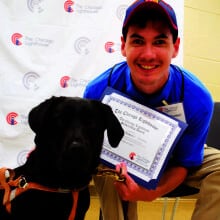Coffee with Kalari: Traveling in the Snow
This article is part of a weekly series written by Kalari, a writer, athlete, mother and employee of The Chicago Lighthouse who is visually impaired. She shares her perspective on a variety of topics in order to build community.

With winter in full force, the joys of traveling in the snow has returned. I actually despise this time of year not only for the frigid temperatures that Chicago is known for, but also for having to travel in the severe elements. Even though I have lived in this city all of my life, I still find it hard to adjust my routine when the weather changes.
When the fresh snow begins to fall, white cane travel becomes more difficult. It is hard to keep track of the sidewalk and I find myself always veering off the path. This is why I love when people shovel the sidewalks. I have seen sidewalks that have been so bad that I would have to walk in the street to get to my destination. As one can imagine, this can be extremely dangerous. I have to keep an ear out for cars and also other pedestrians to ensure my safety.
I also hate the ice. I am usually an extremely fast walker, but I find that with ice I need to force myself to walk much slower. I prefer to get where I am going quickly, and I find that the time it takes me to walk one particular block often doubles. Having all of these things in mind, I often switch my routes to travel more efficiently. I try to stay on the main streets where many businesses are located because these sidewalks are typically clear. This takes me out of my way, but I do not mind if I can safely walk on a sidewalk. I usually try to catch public transportation on main streets because the bus stop would be clear and I do not have to climb over a mountain of snow just to board.
I spoke to Jaret Bozigian, Orientation and Mobility Specialist at The Chicago Lighthouse, about the challenges that people who are blind face when traveling in the snow and ice. According to Jaret, the snow makes it challenging for white cane travelers to locate the sidewalk. He recommends using a combination of the constant contact and two-point touch cane techniques. The constant contact technique is when the white cane maintains constant contact with the ground. The two-point touch technique is when the cane taps the walkway once on each side as the traveler walks. A combination of these two techniques helps the cane traveler locate and stay on the sidewalk.
“Another helpful technique is called the dig technique,” says Jaret. “With this technique, each time the cane touches the ground, the traveler pushes iy forward a little bit to dig into the snow and identify where the sidewalk is,” he says.
In addition to these cane techniques, he also recommends wearing thinner gloves to grip the cane easier and a knitted hat that does not obstruct sound for the ears.
These are just a few tips and tricks for traveling through snowy conditions. I would love to hear your experiences for traveling in snow. What is your approach? I would love to hear your stories!






